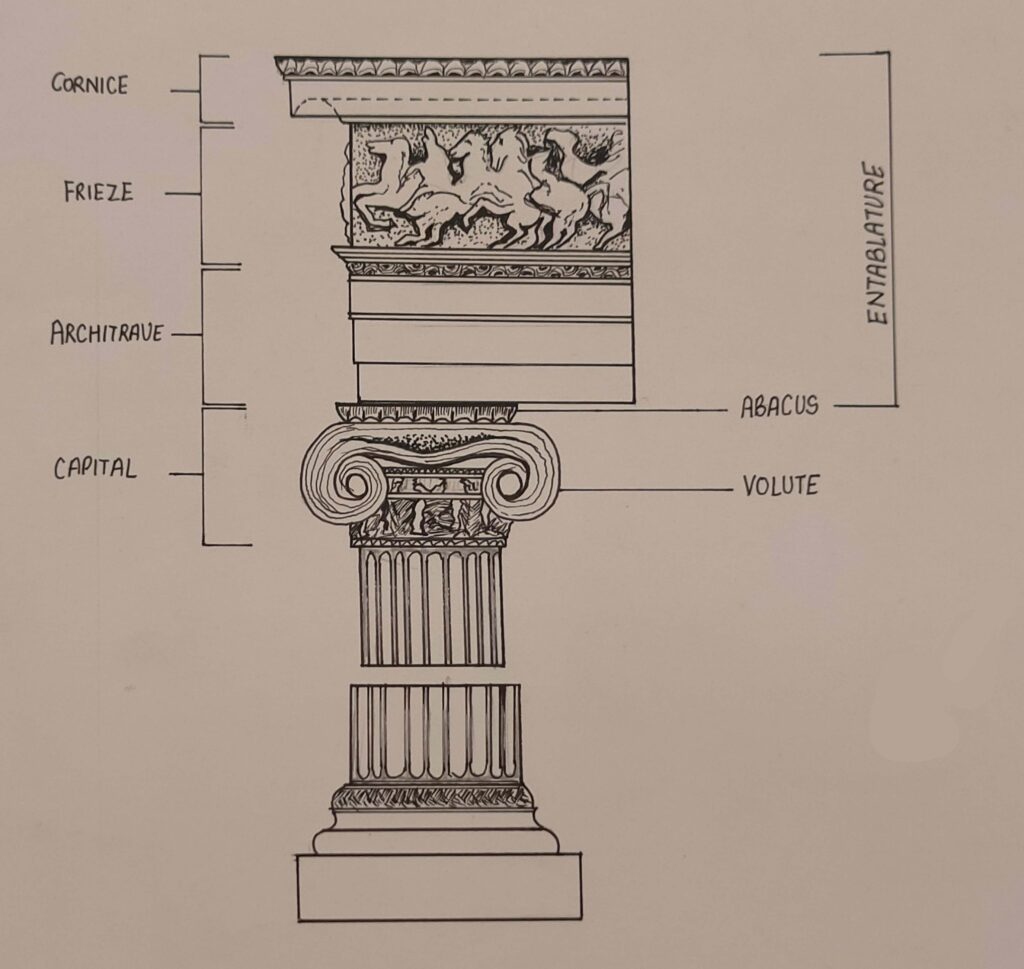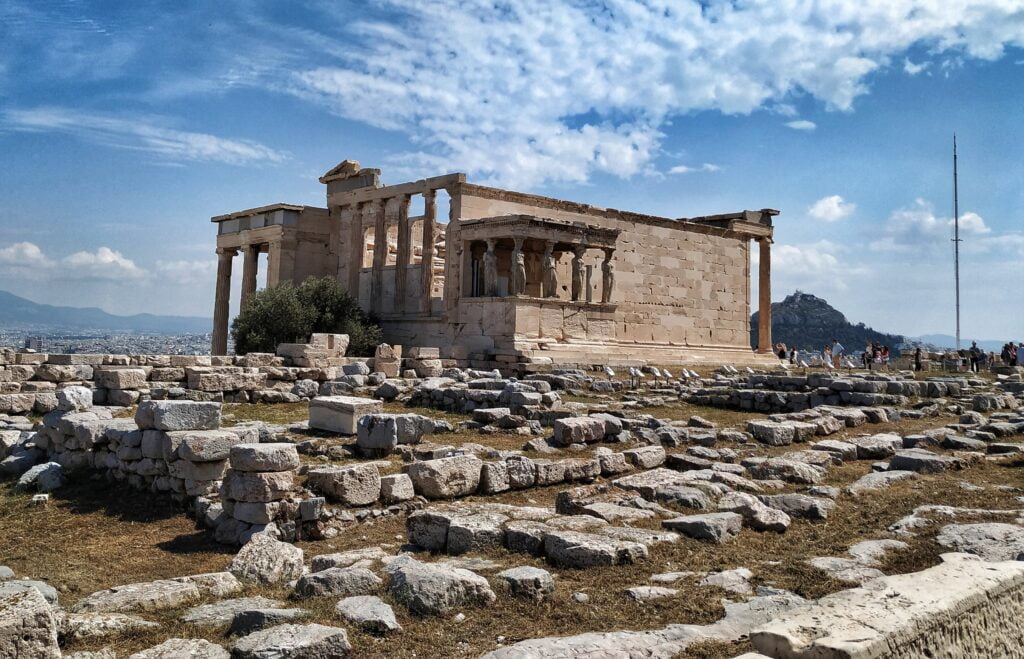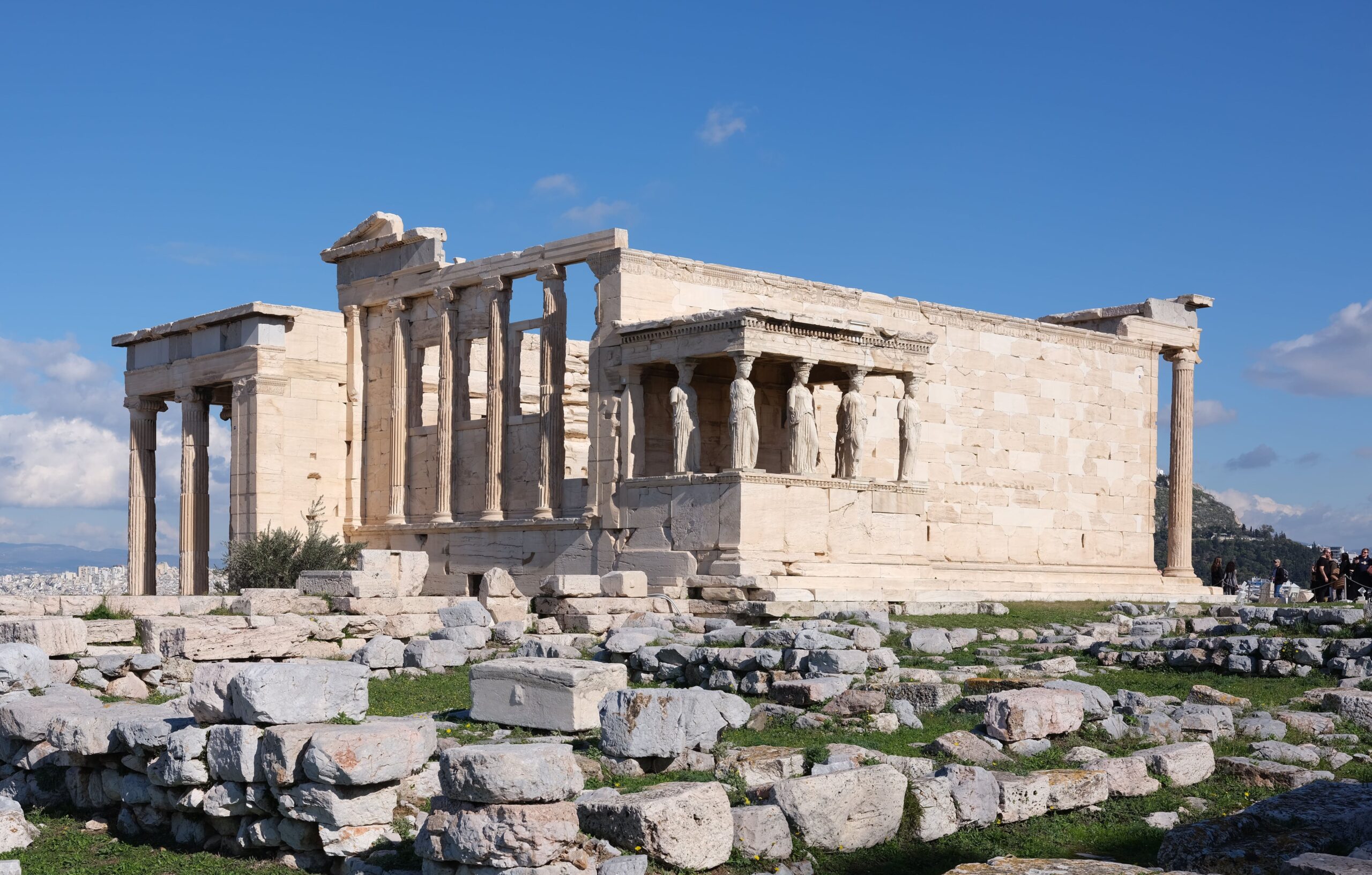Types of Greek Order
- Doric Order
- Ionic Order
- Corinthian Order
Types of Roman Order

Introduction of Greek Ionic Order
The Ionic order is one of the classical orders of Greek architecture; the other two are the Doric and Corinthian orders. The Ionic Order first originated in Ionia, a coastal region of central Anatolia (in present-day Turkey). At that location, a number of Greek settlements were present. [1] It was developed shortly after the Doric Order in the mid-sixth century B.C.E., and it became popular on mainland Greece following that century. The design of ionic architecture was brought about by the elements of the female body, as Doric architecture was modeled after the male body. It was suggested by the ancient Roman architect Vitruvius. [2] The Ionic order is known for its distinctive capital, which features volutes or scrolls on either side.

Sketch by Shivani Lohiya
The Greek Ionic Order
This order is named after the Ionians of ancient Greece. The order is taken from the temple of ‘Erechtheion’ built in the year 409 B.C. It is situated to the north of the Parthenon and was constructed by the architect Mnesicles at the time of Pericles to replace the original sanctuary, which was burned by the Persians in 480 B.C.
(i) Column: The column has a base. The column height, including base, shaft, and capital, is usually nine times the lower diameter.
The molded base, which is semi-diameter in height, consists of an upper and lower ‘torus’ separated by ‘scotia’ and fillets. The torus is the molded disc with a ‘guilloche’ or plait ornament. The scotia is a concave molding lying between the upper and lower torus and is generally not enriched. It throws deep shadows. The lower torus is 1.5 times the diameter of the column shaft. The molded base was finally brought to this perfect form in ‘Attica’, and hence it came to be known as ‘Attic’ base.
The circular shaft has 24 flutes separated by fillets and not by arrises, as in Doric order. The shaft diminishes to 5/6 the diameter at its top. The inter-columniation is 4D.
The Ionic Order is especially remarkable for its volute or scroll capital or decorative motif derived from lotus, nautilus shell, or ram’s horns. The capital, which is 3/4 to 2/3 diameter high, has a pair of volutes both on the front and back of the column, connected at sides by the concave cushion, either plain or ornamented, with flutes, fillets, and beads. The volutes are placed parallel to the entablature. The out-lines of the volutes are obtained either by geometrical construction or by smooth freehand. The capital, with its two volutes, produced difficulty at the corners of the rectangular buildings. The difficulty was skillfully solved by providing volutes on both the outside faces of the capital and bringing the two corner volutes together on the diagonal. In between the volutes is the necking, enriched with egg and tongue and honey suckle ornaments separating the capital from the fluted shaft.
Above the spiral scrolls, there is an abacus, which is shallow but not deep, as in the case of the Doric order. It is either plain or enriched with egg and tongue ornaments.
(ii) Entablature: The ionic entablature varies in height but is usually about two diameters high. It consists of the following:
(a) Architrave: It is 3/4 diameter in high. It consists of triple fasciae, i.e., three beams projecting one above the other. The top cyma reversa contains a ‘leaf and dart’ ornament.
(b) Frieze: It is either plain or ornamented by a continuous band of sculptures. It is 3/4 diameter in high.
(c) Cornice: It has a similar treatment to Doric Order. It is semi-diameter high. There are usually no antifixae on the flanks, but cymatium is elaborately enriched by lotus and papyrus ornaments. It is also carried along the side cornices, and rainwater spouts in the shape of lion’s heads are provided at regular intervals to drain out the rainwater from the roof.
The corona is plain and supported by a cyma bead molding if it is of “Attic’ type and with dentils if it is of ‘Denticular’ type.
The Greek Ionic Order is more ornate than the Doric. It has grace, elegance, and refinement in its outlines. (Source: World Architecture by G.K Hiraskar, Page 233-234)
Proportioning of Greek Classic Orders
The following table shows the proportioning of the Greek Orders. (Source: World Architecture by G.K Hiraskar, Page 230)
| Name of Greek Order | Height of column in terms of lower Dia. | Height of Entablature in Terms of lower Dia. |
| Doric | 7 | 2 |
| Ionic | 9 | 2 |
| Corinthian | 10 | 2 whole 1/4 |
Features and Characteristics of Greek Ionic Order
Column: Ionic columns are slender and typically have 24 flutes. The column is more slender compared to the Doric order and is characterized by a base.
Capital: The most recognizable feature of the ionic order is its capital. The capital consists of a volute on each side, which is a spiral scroll-like ornament.
Entablature: The entablature of the Ionic order consists of three main parts: the architrave, frieze, and cornice. The architrave is usually divided into three horizontal bands, and the frieze often contains decorative elements.
Base: Ionic columns rest on a base, which is not present in the Doric order. The base provides additional height for the column.
Fluting: The columns are typically fluted with 24 concave grooves that run vertically along the shaft.
Height-to-Diameter Ratio: Ionic columns are generally more slender than Doric columns. The height-to-diameter ratio of ionic columns is typically around 9:1.

Examples of Ionic Order in Architecture
- Erechtheion (Athens, Greece)
- Temple of Artemis at Ephesus (Ephesus, Turkey)
- Ionic Stoa of Attalos (Athens, Greece)
- Temple of Hera (Samos, Greece)
- Temple of Apollo Epicurius (Bassae, Greece)
Introduction of Roman Ionic Order
The Ionic order is one of the classical orders of Roman architecture; the other four are Doric, Corinthian, Composite, and Tuscan. The order was taken from the temple of Fortuna Virilis in Rome. The order uses flutes from the Doric order with the addition of volutes, which are present in spirals on either side of the capital like a nautilus. It is characterized by its distinctive capital, which features volutes, or scroll-like ornaments, on either side. It is considered more decorative and slender compared to the Doric order.
The Roman Ionic Order
The order is taken from the Temple of Fortuna Virilis in Rome (c. 40 B.C.). The temple is rectangular in plan and is located near the banks of the Tiber.
(i) Column: The column, including base, shaft, and capital, is nine diameters high. The base is semi-diameter high. It has an upper and lower torus separated by a scotia and a fillet.
The circular shaft has 20 flutes separated by fillets, which are one-third of the width of the flutes. The shaft diminishes to 5/6 the diameter at the top. The inter-columniation is 3 D.
The ionic order is distinguished by its volute capital, which is generally enriched with carved ornaments.
The capital, which is semi-diameter high, is enriched in between the volutes with ‘egg and tongue ornament and ‘reel and bead’ molding. The roll is carved with leaves, while the rosette is often engraved in the circle, forming the eye of the volute. Above it, there are echinus and a shallow abacus. In some ionic orders, it has been seen that the spiral scrolls are on all four sides of the capital, which provides symmetrical treatment at corner columns. However, this arrangement is less satisfactory than the one with spiral scrolls parallel to the entablature. The capital projects one half of the semi-diameter of the column on each side.
(ii) Entablature: It is 24 inches high and contains an architrave, frieze, and cornice, the details of which are as follows:
(a) Architrave: The architrave, which is the diameter in height, is heavy and richly decorated. It has four to five raised slabs, one projecting above the other. The cyma reversa of the architrave is decorated with acanthus leaves, while the lower slab contains ‘bead and reel’ mouldings.
(b) Frieze: The frieze is flat and contains a continuous band of sculpture. Its diameter
(c) Cornice: It is 7/8-diameter high and contains cymatium and corona. It projects equal to its height. The cymatium is decorated with acanthus leaves and provided with water spouts in the form of lion’s heads at regular intervals to drain out the rainwater.
The corona is usually large and consists of three to four horizontal slabs projected one above the other. It is supported by dentils above which lie quarter-round mouldings containing ‘egg and tongue’ ornaments. The cyma reversa under the dentils is enriched with the leaf and tongue ornament.
The Roman Ionic Order is overloaded with heavy and bold ornaments. The semi-circular moldings lack refinement. (Source: World Architecture by G.K Hiraskar, Page 255-257)
Proportioning of Roman Classic Orders
The following table shows the proportioning of the Greek Orders. (Source: World Architecture by G.K Hiraskar, Page 253)
| Name of Roman Order | Height of column in terms of lower Dia. | Height of Entablature in Terms of lower Dia. |
| Doric | 8 | 2 |
| Ionic | 9 | 2 whole 1/4 |
| Corinthian | 10 | 2 whole 1/2 |
| Composite | 10 | 2 whole 1/2 |
| Tuscan | 7 | 2 whole 1/3 |
Features of Roman Ionic Order
Capital: The Ionic capital in Roman architecture is similar to the Greek Ionic capital, featuring volutes on each side. However, Roman variations may exhibit some differences in proportions and details.
Entablature: The entablature in Roman Ionic order architecture consists of the architrave, frieze, and cornice. The Romans often added more elaborate ornamentation to the frieze compared to the Greeks.
Columns: Roman Ionic columns typically have 20 flutes and are more slender compared to the Greek Doric columns. The Romans sometimes used engaged or half-columns against walls rather than freestanding columns.
Base: Roman Ionic columns often rest on a base, providing a transition between the column and the supporting surface. The base can vary in design and height.
Decoration: The Romans were known for their elaborate ornamentation, and this was reflected in the Ionic order.
Examples of Roman Ionic Order
- Temple of Portunus (Temple of Fortuna Virilis), Rome, Italy
- Maison Carrée, Nîmes, France
- Temple of Saturn, Rome, Italy
- Temple of Portunus, Rome, Italy
- Theatre of Marcellus, Rome, Italy











